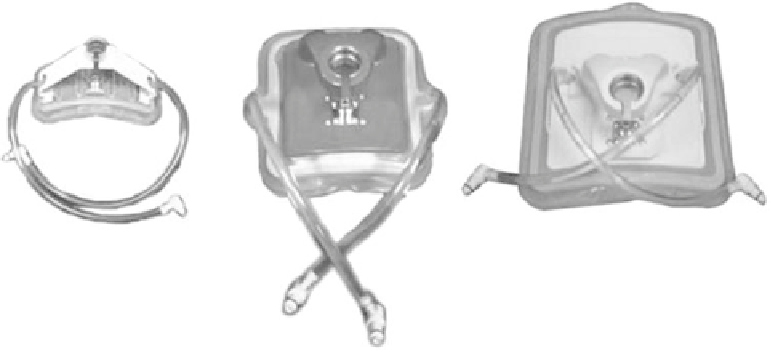Biomedical Engineering Reference
In-Depth Information
The ability of the patient to walk around with the applicator
mounted is unique. An interesting option that still needs fur-
ther investigation is that the DCC applicator opens the pos-
sibility to simultaneous radiation and hyperthermia as the
applicator is radiation transparent.
TABLE 8.1
Contact Curved Microstrip Applicators of Alba
Hyperthermia System
Applicator Type
Aperture Size (cm)
EFS (cm
2
)
HC
Weight (kg)
α
7.3 × 19.8
3.6 × 15.8
0.26
0.7
0.32
0.9
β
14.8 × 14.4
8 × 11.5
0.34
1.5
Advantages: conformal applicator; high comfort for the
patient; rapid and accurate application to
the treatment region; integrated water bolus;
applicator size does not compromise its use;
excellent spatial power control.
Disadvantages: penetration depth ≤2 cm; SAR pattern sensi-
tive to air enclosures in water bolus.
γ
19.8 × 19.8
11.3 × 18
EFS = effective field size (area enclosed by 50% is oSAR contour line at 1 cm
depth); HC = homogeneity coefficient (ratio between the area corresponding
to 75% of SAR
max
and the area corresponding to 25% of SAR
max
).
an Oxford Optronix Laser Doppler Probe Oxylab (Oxford, UK)
to collect information on the local blood perfusion in the micro-
circulation bed.
8.5.1.2 Commercially available Superficial
Hyperthermia Systems
8.5.1.2.1 Alba
The ALBA system for superficial hyperthermia is a compact
system with all required technology integrated in a single cab-
inet, is fully computerized, operates at 434 MHz, has a maxi-
mum RF-power output of 200 W, and includes a temperature
and flow-controlled water bolus system [60]. There is a choice
between three contact microstrip applicators of different size as
specified in Table 8.1; all are slightly curved to easily conform to
the body surface; the water bolus is integrated with the applica-
tor (see Figure 8.8). Temperature is measured by miniature type
T-thermocouples (4 to 16 channels, 50 μm diameter, Oxford
Optronix Ltd.) using a power-pulse technique introduced by the
Leeuw et al. (61) to minimize the effect of RF interference and
probe self-heating on resulting temperature reading. Additional
features of the system include an ultrasound scanner (HS 2000,
Honda, Japan) for accurate verification of the position of the
thermocouple probes with reference to tumor tissue, as well as
8.5.1.2.2 BSD-500
The BSD-500 system is a complete and versatile system that
offers all instrumentation needed for interstitial hyperther-
mia and superficial hyperthermia with three different-sized
single waveguide type applicators as well as two multi-ele-
ment spiral applicators. The system has eight independently
controlled RF-power output channels at a frequency of 915
MHz that can be operated asynchronously for superficial
hyperthermia or in an electronically controlled synchronous
phase mode for interstitial hyperthermia. For thermom-
etry the system is equipped for maximal eight RF-immune
Bowman temperature probes.
Originally, the BSD-500 came with the MA-100 and MA-120
side-loaded waveguides, and the MA-151 mini-dual-ridge
waveguide (FDA approved, Figure 8.9). Details on the appli-
cator specifications are presented in Table 8.2. Side loading
of waveguides with high dielectric slabs is historically well
FIGURE 8.8
Contact curved microstrip applicators: α, β, and γ from the ALBA system for superficial hyperthermia.















